Established in August 2018 by the U.S. Department of Energy, the LaserNetUS initiative provides U.S. scientists with increased access to unique, high-intensity laser facilities.
KARL KRUSHELNICK, ALEC THOMAS, AND LOUISE WILLINGALE, UNIVERSITY OF MICHIGAN
Since the invention of chirped pulse amplification (CPA) in 1985 by two of the three winners of the 2018 Nobel Prize in physics — Gérard Mourou and Donna Strickland — and the subsequent development of this technology into ultrahigh-power laser systems in the 1990s, there has been an explosion both in the amount of research in this field and in the number of new areas of investigation that have been enabled by these lasers. The exciting results from such work have also led to many potentially important scientific and technological applications.
One of the keys to future discoveries in high-field science is the availability of appropriate laser drivers that can create unique states of matter and that can also be used to generate ultrashort sources of radiation and particles for probing such states. Petawatt-class lasers (1015 W) are able to address these frontier research areas, including investigations into particle acceleration, bright radiation sources, laboratory studies of astrophysical phenomena, and research into the fundamental nature of ultrahigh-field laser interactions with matter and even with the vacuum itself.
Although CPA and the first petawatt laser were both developed in the U.S., recently there has been particularly impressive growth in this research field in Europe and Asia, with investments
of more than a billion dollars in new facilities over the past several years.
Consequently, in response to increased international competition, the U.S. Department of Energy formed a consortium in 2018 to establish a national network that includes all of the petawatt-class laser systems in the U.S. — at the University of Michigan, Ohio State University, the University of Texas, the University of Nebraska, Colorado State University, Lawrence Livermore National Lab, Lawrence Berkeley National Lab, the Laboratory for Laser Energetics, and the Stanford Linear Accelerator Center (SLAC). The lasers in this consortium will act as domestic user facilities to enable a broad range of frontier scientific research and expand the community of researchers in this area to encompass academia, national laboratories, and industry.
This consortium is called LaserNetUS and is directly responsive to recommendations made in a recently released National Academy of Sciences report entitled “Opportunities in Intense Ultrafast Lasers: Reaching for the Brightest Light.” LaserNetUS was established particularly to help U.S. researchers enter this field, enabling their access to experimental time on the high-intensity laser systems at the LaserNetUS host institutions.
High-intensity lasers in the consortium, such as the HERCULES laser system at the University of Michigan (Figure 1), have a broad range of potential applications in basic research, industry, and medicine. All of the LaserNetUS facilities are high intensity and can operate well into the relativistic regime, which extends roughly in intensity beyond 1018 W/cm2 for 1-μm wavelength laser radiation. Such an intensity corresponds to a laser electric field that will oscillate electrons in the laser focus to energies greater than their rest mass. This fundamentally changes the dynamics of the interaction such that the particles and radiation generated by the laser-matter interaction are often highly directional (i.e., they are “beamed”). At even higher intensities beyond 1024 W/cm2, which is much larger than any intensity achieved yet, the motion of protons in the laser field becomes relativistic and quantum radiation reaction starts to dominate the electron dynamics.
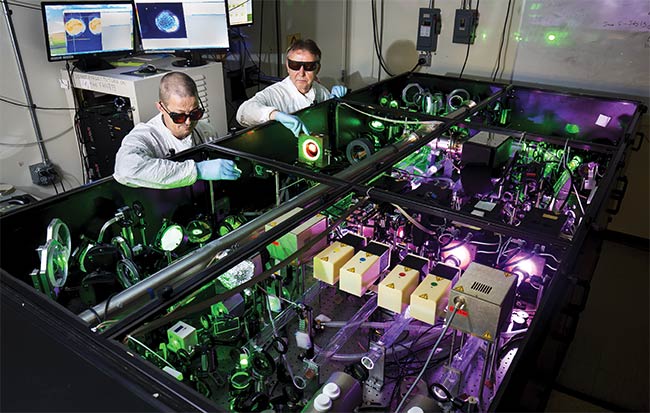
Figure 1. Aligning the final amplifier of the HERCULES laser system. Courtesy of Joseph Xu/University of Michigan.
At present, the highest peak intensities available exceed 1022 W/cm2 and have been demonstrated at the University of Michigan using HERCULES, as well as at several other facilities around the world. There are now plans for future facilities that could actually reach the ultrarelativistic regime, such as the Extreme Light Infrastructure facilities under construction in Europe.
Plasma waves
The electric field of a laser beam is transverse to its direction of propagation, so in order to produce an accelerated beam of electrons along the direction of the laser pulse, a relativistic plasma wave (having longitudinal electric fields) must first be generated by the laser pulse and then be used for acceleration. In this laser wakefield accelerator (LWFA) configuration, the waves are produced in the wake of the pulse as it propagates through a low-density plasma (Figure 2). The peak energy produced by LWFA is now approaching 10 GeV (giga electron volts). Such laser-driven electron accelerators not only promise to provide future compact, low-cost colliders for high-energy physics experiments but can also act as tabletop sources of ultrashort-electron, secondary-particle, and x-ray pulses for both applications and discovery science.
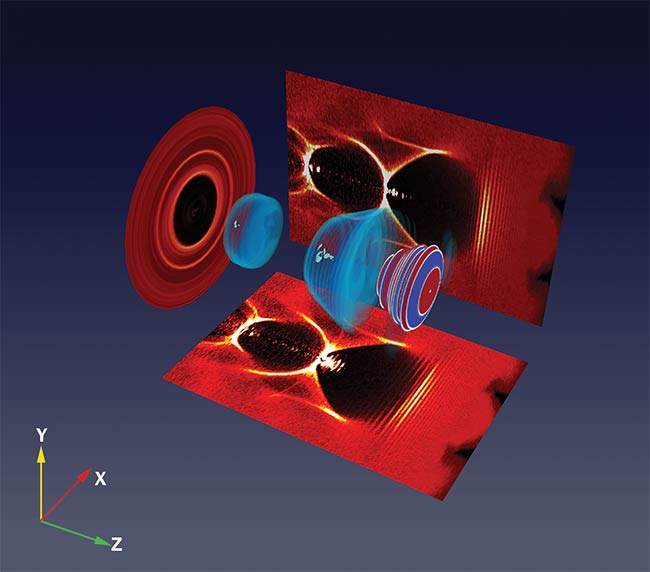
Figure 2. 3D particle-in-cell simulation of laser wakefield generation (light blue) in underdense plasma. The 30-fs laser pulse traveling left to right generates a wakefield to accelerate electrons. Simulation box size is 50 µm × 50 µm × 100 µm. Courtesy of Daniel Seipt/University of Michigan.
Methods are now also being directed toward significantly improving the
quality of these electron beams — for
obtaining low emittance and energy spread through use of well-controlled
gas targets or multiple laser pulses, for operating at a very high repetition rate, and for increasing energy gain beyond
10 GeV in a single stage. The advent of high-charge GeV electron bunches and bright MeV (mega electron volt) x-ray pulses also brings new possibilities for generating ultrashort, low-emittance
positron bunches suitable for colliders, and for generating ultrashort muon pulses suitable for high-resolution radiography.
Improvements in the properties of laser-generated electron beams should enable the development of compact x-ray free-electron lasers (XFELs) that can use the unique properties of such laser-
generated electron bunches, including
low-energy spread, milliradian divergence, and ultrashort duration. A laser-driven accelerator-based XFEL will complement large-scale facilities — such as the Linear Coherent Light Source at SLAC — which offer intense x-ray pulses, albeit with limited user access, for a wide range of ultrafast experiments.
Strong-field QED
Strong fields in quantum electrodynamics (QED) are those that are stronger than the QED-critical field, which is equivalent to the electric field that would accelerate an electron to its rest mass energy in a reduced Compton length. It is the threshold at which nonlinear QED effects become significant, including production of matter from the vacuum. Such fields are far stronger than can be achieved with lasers in the laboratory frame. Since electric-field strength is not a Lorentz invariant, however, nonlinear quantum effects can be accessed at significantly lower field strengths by interacting with relativistic particles. Moreover, since strong laser fields can accelerate particles
to relativistic energies, nonlinear quantum effects will arise naturally in the next generation of intense laser-plasma interactions (Figure 3). Experiments on the effects of strong-field QED lie at the very frontier of relativistic plasma physics.
Radiation reaction is one such effect, where electrons rapidly lose energy because of radiation emission during extreme accelerations, such as those in an intense laser field. It has both classical and quantum regimes that are only now beginning to be explored.
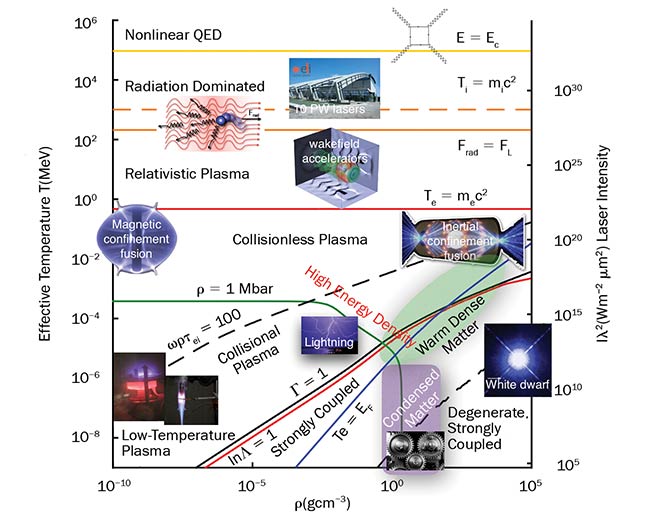
Figure 3. As the intensity rises, matter generated in laser-plasma interactions passes through high-energy-density, relativistic plasma; radiation-dominated plasma; and nonlinear QED regimes. Courtesy of University of Michigan.
In the first experiments published last year, a short-pulse laser was used to drive a laser wakefield accelerator to generate pulsed electrons with GeV energies. A second short laser pulse with intensity ~1020 W/cm2 propagated counter to the electron pulse, which boosts the electric fields experienced by the electrons by a factor of 1000, resulting in nonlinear inverse Compton scattered gamma rays. In cases where a successful collision was found to occur, substantial electron energy loss and gamma radiation emission was observed; however, detailed comparisons with theory have yet to be performed. Planned experiments using a similar geometry will investigate whether electron-positron pairs can be produced from the vacuum itself at extreme intensities through the decay of the gamma
rays into electron-positron pairs. These experiments require intense lasers and challenging multiple-beam or tight-focusing geometries.
At even higher intensities, beyond
1024 W/cm2, the relativistic electrons generated directly in the oscillating laser fields will experience boosted strength fields exceeding the critical field strength, leading to the possibility of pair cascades generating dense, neutral electron-positron plasma in the laboratory starting from nearly vacuum conditions.
Laboratory astrophysics
Collisionless shocks are common in many space and astrophysical environments, including around Earth and the planets of the solar system, the heliopause, and supernovae remnants. Unlike hydrodynamic shocks that dissipate energy through particle collisions over length scales on the order of the mean free path, collisionless shock energy is dissipated through electromagnetic effects over far shorter-length scales. High-intensity experiments have observed laser-generated unmagnetized electrostatic collisionless shocks, as well as the formation of high-Mach-number magnetized collisionless shocks.
Colliding plasmas with opposite magnetization can also create a strongly driven magnetic reconnection geometry. Magnetic reconnection is a fundamental and ubiquitous process in magnetized plasmas throughout the universe. Reconnection allows complex magnetic-field structures to relax topologically and to transfer energy to the background plasma, and it is one of the most striking examples of self-organization in plasma physics. Reconnection plays a central role in phenomena as diverse as fusion plasmas, magnetospheric substorms, solar or stellar flares, and gamma ray bursts (GRBs). These are some of the most challenging problems in plasma physics. Magnetic reconnection is an excellent example of a problem where earthbound dynamical laboratory astrophysics experiments can elucidate the fundamental physics behind astrophysical observations.
Reconnection in many extreme astrophysical environments also occurs in so-called relativistic regimes, including
pulsar winds, active galactic nuclei (AGN) jets, and GRBs. In the relativistic reconnection regime, the novel physics is the generation of relativistic outflows leading to efficient energy conversion. Experiments with short-pulse lasers may open a new opportunity to study particle acceleration mediated by magnetic reconnection in relativistic regimes, including the role of instabilities.
Electron-positron plasmas
Though rarely observed in terrestrial laboratories, relativistic electron-positron (e+e−) plasmas are likely common in the high-energy universe, in matter created during the first few seconds after the Big Bang, in pulsar winds, in the jets of blazars, as well as in GRBs. The physics of this exotic state of matter, however, has been relatively unexplored because of the lack of laboratory experiments. Ultraintense lasers are capable of producing copious amounts of multi-MeV e+e− pairs in the laboratory, with densities exceeding 1020 cm−3 and magnetic fields exceeding 109 G.
The creation of such exotic high-energy-density plasmas may open entirely new frontiers in both astrophysics and basic science. In particular, GRBs remain one of the most enigmatic high-energy phenomena in the universe. They represent the extreme end of cosmic blast waves, whose detailed physical understanding can be improved with better knowledge of high-energy density and relativistic plasma physics. With new laser systems capable of producing relativistic pair plasmas, collisionless shocks, and relativistic reconnection, it may soon be possible to create a GRB in a lab.
Ion acceleration
Intense ion beams are one of the secondary radiation sources that result from the interaction of intense laser pulses with solid targets at relativistic intensities. The extraordinarily high beam quality of this source enables it to be used for imaging laser-plasma interaction physics (Figure 4), shedding light on the fundamental coupling dynamics for a broad range of laser intensities and pulse parameters. For higher laser intensities, I > 1021 W/cm2, acceleration of ions from thin-foil targets is in a regime of fundamental interest; however, such experiments would also benefit medical proton therapy applications, which require typical energies of 250 MeV — which are not yet achievable using lower intensity lasers.
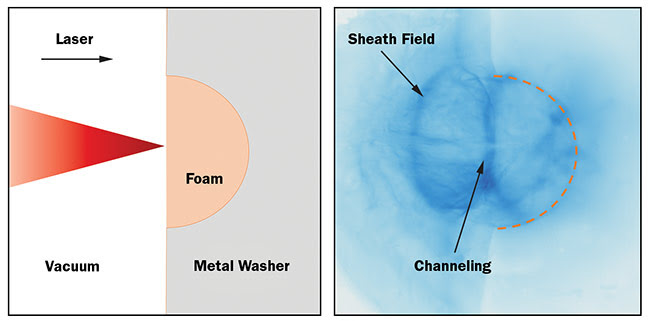
Figure 4. Schematic of high-power laser interaction with low-density foam target (a). Proton-probing image of electric fields produced during an intense laser interaction in configuration from part a (b). Image size ~2.5 mm × 2.5 mm. Courtesy of University of Michigan.
Compared to other neutron sources, high-intensity laser-based neutron generation (i.e., using a laser-driven light-ion accelerator neutron source) is unique because of the potentially compact size of the system, and its short-pulse duration (less than a few nanoseconds) and consequent high brightness. Laser-based neutron sources typically rely on a few specific fusion (or stripping) reactions. Typically, light ions (protons, deuterium, or even tritium) are accelerated and
collide with other low-Z materials to generate neutrons. The scheme using a secondary target has been employed to generate directional sources of fast neutrons.
X-ray and gamma ray sources
By creating extremely high-energy densities, intense lasers are enabling the development of a new generation of bright x-ray light sources, which are now small enough to fit in a university laboratory. Not only are these sources both powerful and compact, they are also able to deliver pulses with ultrashort-pulse duration (attosecond to femtosecond), leading to new discoveries in ultrafast science. The photon energy of these sources covers the range extending from XUV (relevant to atomic, molecular, and material dynamics) to hard x-rays (leading to discoveries in inner-shell atomic physics) to gamma rays (for nuclear physics). Their source size has micron scales, which enables imaging with micron-scale spatial resolution, as well as high spatial coherence for phase contrast (Figure 5). Such compact
light sources enable application of techniques that were formerly available at only a few national research facilities worldwide.
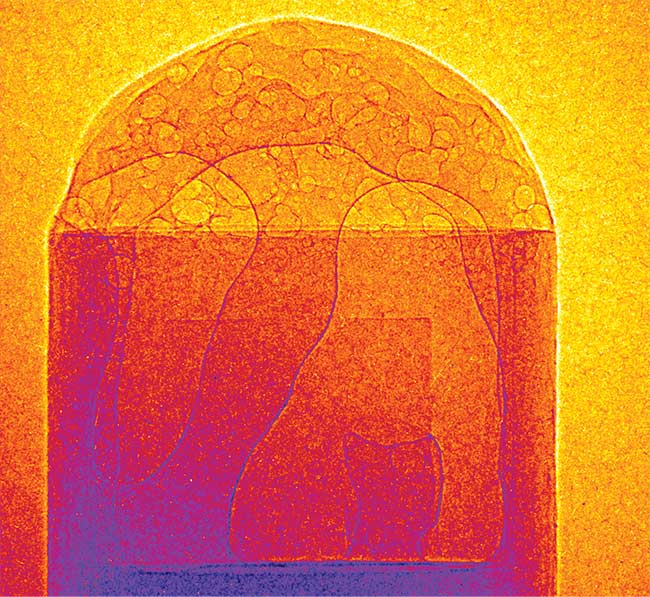
Figure 5. Phase-contrast image of bubbles forming in grease, recorded in a single shot using betatron radiation peaked at 10 keV photon energy. Courtesy of University of Michigan.
The most recent milestones achieved in the development of such all-laser-driven x-ray sources include demonstrations of micron source size, narrow x-ray bandwidth, and wide photon-energy tunability. These characteristics are highly advantageous for advanced x-ray applications in research, industry, defense, security, and biomedicine.
Meet the authors
Karl Krushelnick is professor of nuclear
engineering and radiological sciences, and director of the Gérard Mourou Center for Ultrafast Optical Science at the University of Michigan; email: [email protected].
Alec Thomas is associate professor of nuclear engineering and radiological sciences; electrical engineering; and computer science and physics at the University of Michigan; email: [email protected].
Louise Willingale is assistant professor of electrical engineering and computer science at the University of Michigan; email: [email protected].